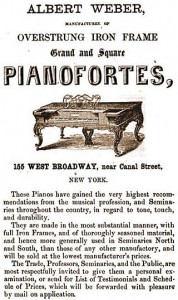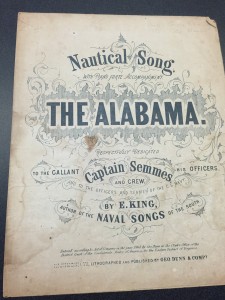In 1864, when “The Alabama,” music composed by Fitz Williams Rosier and lyrics written by Edward King, was published, the piano was well-established as an instrument for music making at home and in small gathering places, such as churches and civic meeting halls. In 1851, 9,000 pianos were built and sold, and by 1860 that number had risen to 21,000.  Increasing hand-in-hand with the piano’s popularity, sheet music was in high demand. Often decorated with elaborate illustrations and given fancy titles, the front covers of sheet music were almost as important as the music contained inside, for the music itself could be of variable quality and similar to other pieces in an age when in response to commercial demand, composers’ goal was to release music as quickly as possible to create music that was accessible to the masses who were mostly beginner and intermediate pianist. A small benefit of the Civil War is that it offered fresh material for composers as the divided nation developed an interest in patriotic songs, such as “The Alabama.”
Increasing hand-in-hand with the piano’s popularity, sheet music was in high demand. Often decorated with elaborate illustrations and given fancy titles, the front covers of sheet music were almost as important as the music contained inside, for the music itself could be of variable quality and similar to other pieces in an age when in response to commercial demand, composers’ goal was to release music as quickly as possible to create music that was accessible to the masses who were mostly beginner and intermediate pianist. A small benefit of the Civil War is that it offered fresh material for composers as the divided nation developed an interest in patriotic songs, such as “The Alabama.”  This piece, characteristic of the era, has an ornate cover, displaying flowing lithography embellished with swirls, flourishes, and leafy designs. While the title is simply, “The Alabama,” after the Confederate ship the CSS Alabama that sunk at the Battle of Kearsage earlier in 1864, the cover provides additional information indicating that it is a “nautical song with piano-forte accompaniment…respectfully dedicated to the gallant Captain Semmes, his officers, and crew, and to the officers and seamen of the C.S. Navy.” True to the uncomplicated nature of pieces from this time, the music for “The Alabama” is simple. Containing eight-bar phrases in the key of F, it has an undemanding rhythm set to common time, and is, of course, written for the piano. With its cover art, title, and simple musicality, “The Alabama” portrays the prevailing trends among sheet music of the 1860s.
This piece, characteristic of the era, has an ornate cover, displaying flowing lithography embellished with swirls, flourishes, and leafy designs. While the title is simply, “The Alabama,” after the Confederate ship the CSS Alabama that sunk at the Battle of Kearsage earlier in 1864, the cover provides additional information indicating that it is a “nautical song with piano-forte accompaniment…respectfully dedicated to the gallant Captain Semmes, his officers, and crew, and to the officers and seamen of the C.S. Navy.” True to the uncomplicated nature of pieces from this time, the music for “The Alabama” is simple. Containing eight-bar phrases in the key of F, it has an undemanding rhythm set to common time, and is, of course, written for the piano. With its cover art, title, and simple musicality, “The Alabama” portrays the prevailing trends among sheet music of the 1860s.
Elise Helton


